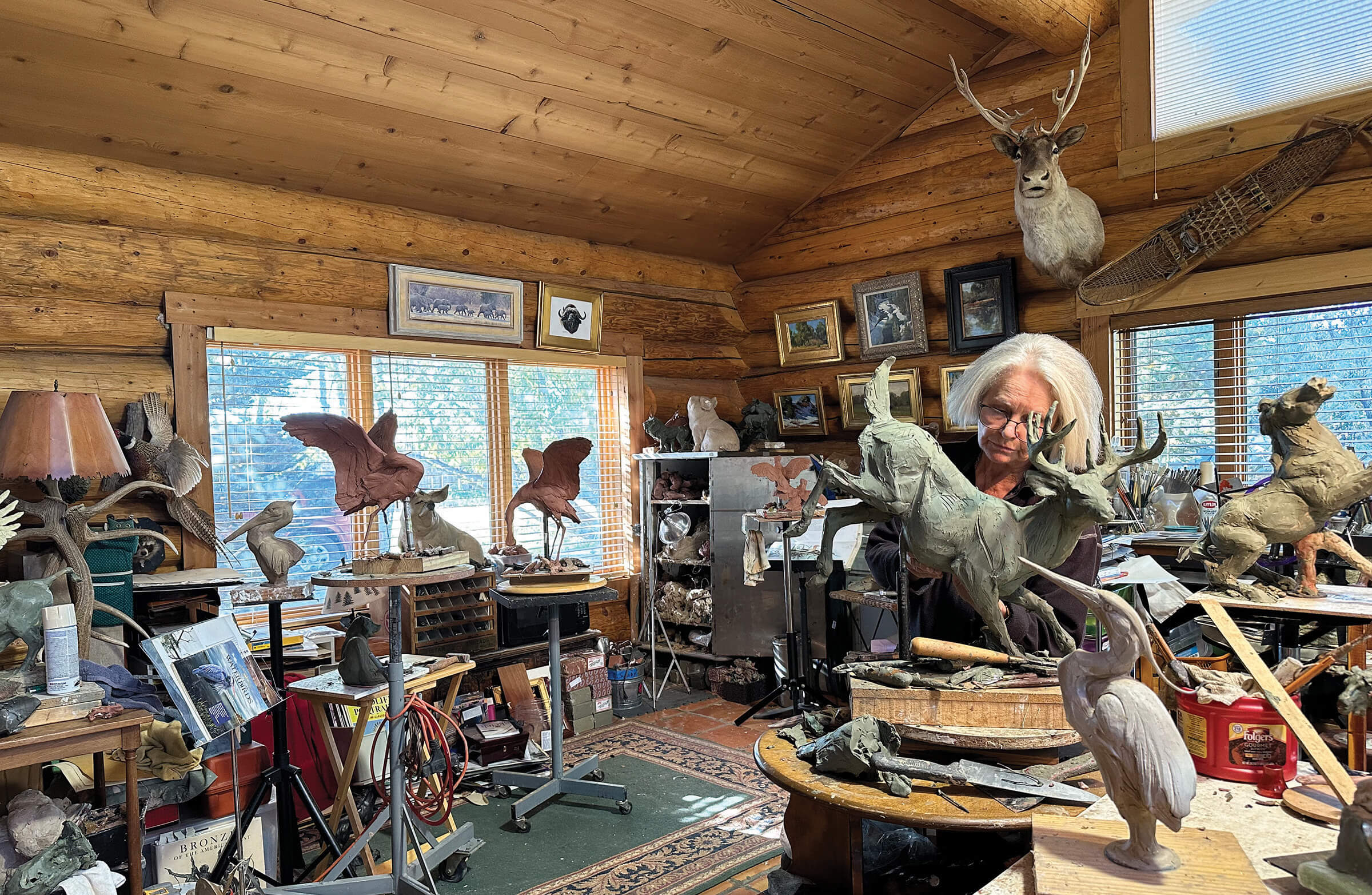
07 Nov In the Studio: Preserving Wildlife in Bronze
Some called it a grizzly miracle. In the newsletter Grizzly Times, Louisa Willcox celebrated the miraculous birth of quadruplets to the matriarchal mama bear #399. “Grand Tetons’ matriarch, Grizzly #399, is perhaps the most famous grizzly bear alive,” wrote Willcox. “Her feat is remarkable for several reasons. For one, at the age of 24, 399 is truly ancient. If 399 has not warranted a proper name before now, maybe Sarah is fitting, in reference to the biblical character who gave birth at 90.”
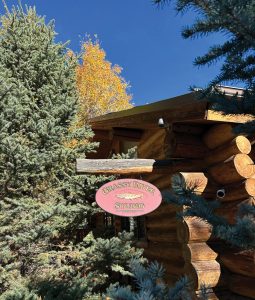
Grassy River Studio sits on the banks of the Popo Agie River in Lander, Wyoming.
The grizzly miracle happened in the spring of 2020 when the world was gripped in isolation during the COVID-19 pandemic; 399 and her quadruplets, born in May, provided a break from bad news. She brought hope and joy to the world, as wildlife photographers followed the family, often seen near roadways, where she’d learned her cubs were safer, protected from aggressive predators in the backcountry. She’d even learned to look both ways before crossing a roadway. Grizzly #399 became a worldwide sensation.
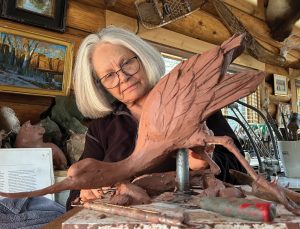
Scott shapes an avocet, one of the many low-country coastal birds in South Carolina, a place where the artist spends considerable time; it was part of a portfolio of wading birds that premiered at The Red Piano Art Gallery in Bluffton and Floyd Fine Arts in Pawleys Island.
Her popularity and that of her offspring became the favorite subject of many, but for artist Sandy Scott of Lander, Wyoming, Grizzly #399 is the symbol of a lifetime achievement. The artist created a monumental sculpture of the mama bear with four cubs romping at her feet, and it was recently installed east of Grand Teton National Park at the National Museum of Military Vehicles in Dubois, Wyoming. Currently, Scott is working on a second commission of Grizzly #399 and her family, which will be installed at the Wilcox Gallery in Jackson, Wyoming, looking out over the National Elk Refuge.
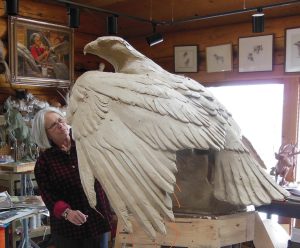
A popular subject for Scott has been the American bald eagle, including her monumental Presidential Eagle on the Sculpture Trail of Jackson, Wyoming’s National Museum of Wildlife Art. Pictured here is another eagle in progress.
Scott, who turned 80 recently, discusses the process of creating the Grizzly #399 monuments. “Turning 80 once seemed insurmountable to me, but here I am. I hit it in July, and I’ve never worked harder in my life — two monuments within the year. Never have I worked on two monuments back to back! The physical labor is something. The first monument was so large that I had to sculpt it at Eagle Bronze. It was exciting modeling the clay to bring 399 to life. She is depicted standing up at 9 feet tall and set on a platform, so I was actually working from a scaffolding most of the time. That takes so much out of you that when you are finished, you want to return to smaller works. But not this time! I’ve never worked harder, never spent more time in my studio, and I’ve never been more energized than I am right now. I’m excited to be creating Grizzly #399 and her family in another monument.”
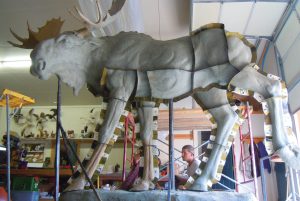
Scott’s studio is filled with works by her artist friends, including a painting by Tom Browning of Scott at work and a series of Conté drawings by her close friend Bob Kuhn. | Moose Flats, commissioned by Tony and Joy Greene for the National Museum of Wildlife Art, is prepared for mold-making. Photos courtesy of the artist
Scott designed and built her studios in Lander in 2000 on 10 acres alongside the Popo Agie River, a tributary of the Wind River. With a large annual production of bronzes, being close to her foundry, Eagle Bronze, drew her to Wyoming. The first building on the property was a 40-by-60-foot monument building, with an upstairs loft for etching and archive storage. With its 20-foot-tall ceilings, Scott created many sculptures here, including the monumental moose and eagle installed on the grounds of the National Museum of Wildlife Art in Jackson and her set of equine gates for the Briscoe Western Art Museum in San Antonio, Texas.
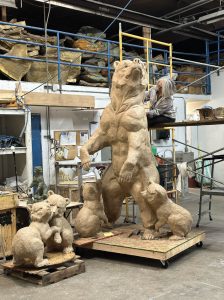
At age 80, Scott still works from scaffolding. She remarks, “One thing you have to remember when working on scaffolding, ‘Don’t step back to look at your work!’”
To this considerable space, Scott added a design studio, a log building that’s 40 by 40 feet, which has an office and bathroom. The design studio is where Scott works on maquettes and sculpts small to medium pieces, such as the shore birds she has been working on for two years. “This studio is designed for smaller works but large enough to sculpt larger pieces, too,” she says. “I recently did a half-size bison for the University of Colorado.”
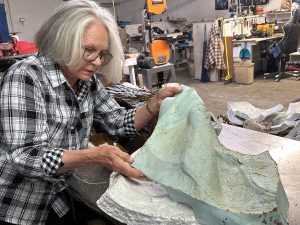
Scott pulls rubber away from a plaster mold and inspects it; the monument to Grizzly #399 was assembled from 74 such molds.
Despite the studio space available to the artist at home, on occasion, the size of her monuments requires that she work at the foundry. “They prepare the armature and block in the foam for me to lay on the clay and model the piece,” Scott explains. “Due to the logistics of moving a huge armatured foam block to my studio, along with weather and deadline considerations, the decision was made to model and mold it at the foundry. It turned out to be a good decision. Wyoming had the worst winter on record, and the huge door to my monument building was iced in.”
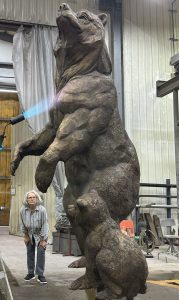
Applying the patina to the monument of Grizzly #399 was the fun part, according to Scott. “The patina is so important to a sculpture that a good patina can sell a bad piece of sculpture while a bad patina can ruin a good piece of sculpture,” she says.
Scott enjoys creating these beautiful monuments depicting the wonders of wildlife. She likes to use big tools to mold and shape swaths of clay. While creating the monument of Grizzly #399, she worked simultaneously in her design studio on a new portfolio for her galleries. “I like the contrasts of working on the monumental work then coming to my design studio where it’s intimate and private; I welcome its counterpoint,” she says.
Jeff Wilcox, gallery director of the Wilcox Gallery, says it’s fitting that Grizzly #399 will have a home in Jackson, as the bear and her offspring, 18 in her lifetime, have wandered through the town over the past 26 years. The monument will be an edition of five, with one remaining in Jackson on public view.
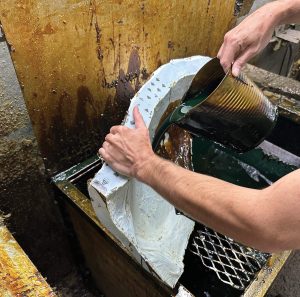
Scott believes that if you want a good sculpture, you must know the processes and work with foundry staff. “My motto is, ‘No surprises.’ My responsibility is to make sure everything is good from the start. The only way to do that is to be involved,” she says. Photos courtesy of the artist
“Once people came to Jackson to see the Tetons, but in recent years, most who come into the gallery have come to see 399 and her cubs,” Wilcox says. “This town should have a monument to her. Who better to create it than Sandy Scott, whose monumental works can be seen on the grounds at the National Museum of Wildlife Art and who lives in Wyoming? This monument depicts 399 as she walks along a roadside with her cubs in tow — that’s what she is famous for.”
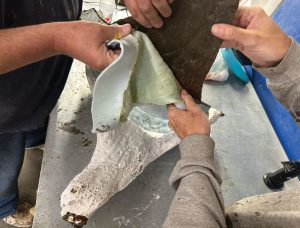
At age 80, Scott shows no signs of slowing down and instead is ramping up her production. She’s represented by a dozen galleries throughout the country, and her latest portfolio of shore birds was presented at two venues in South Carolina: Floyd Fine Arts on Pawleys Island and The Red Piano Art Gallery in Bluffton. Nearby, Brookgreen Gardens, a sculpture garden, wildlife preserve, and designated National Historic Landmark on South Carolina’s Hammock Coast, exhibits Scott’s sculptures in their permanent collection. She is also an elected trustee at Brookgreen.
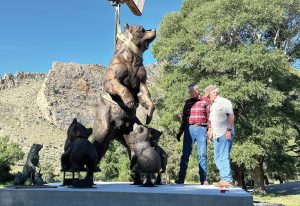
The monument to Grizzly #399 was installed with the mama bear looking toward the Grand Tetons, her birthplace, and where her many cubs were born and raised. Dan Starks, who commissioned Scott to create the work, requested this detail. Additional landscaping and a plaque of #399’s story are also underway. Photo courtesy of the artist
Some of the country’s finest Western art shows feature Scott’s work, keeping her design studio popping. She has shown for 36 years with Prix de West at the National Cowboy & Western Heritage Museum in Oklahoma City and for 35 years with Western Visions at the National Museum of Wildlife Art. She also participates in Masters of the American West at the Autry Museum in Los Angeles; Quest for the West at the Eiteljorg Museum in Indianapolis, Indiana; at the annual art show and sale at the Buffalo Bill Center for the West in Cody, Wyoming; and her newest show at the Cowboy & Western Heritage Museum, Small Works, Great Wonders.
Scott is scheduled to receive an honorary doctorate in the spring of 2024 from Andersen University in South Carolina. She has also been recognized with awards from professional organizations including the National Academy of Design, the Society of Animal Artists, The National Arts Club; and she’s a fellow of the American Artists Professional League and the National Sculpture Society.
WA&A senior contributing editor Shari Morrison has been in the business of art for more than 40 years. She helped found the Scottsdale Artists’ School and the American Women Artists and directed the Santa Fe Artists’ Medical Fund for some years.






No Comments